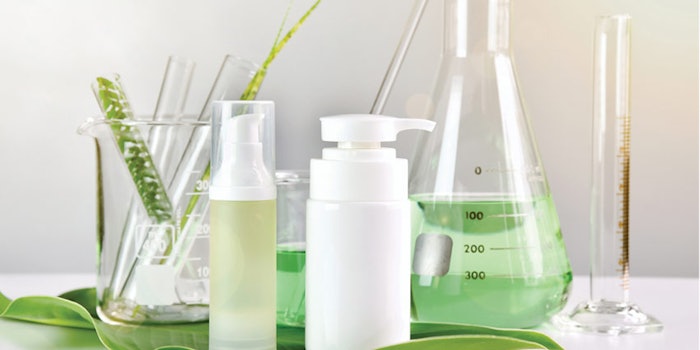
Studying and synthesizing cosmetic ingredients has gone on for many years, but it now has had a resurgence under the name biomimetic science. How is biomimetic science relative to the cosmetics industry? Merriam-Webster defines biomimetics as,“The study of the formation, structure, or function of biologically produced substances and materials (such as enzymes or silk) and biological mechanisms and processes (such as protein synthesis or photosynthesis) especially for the purpose of synthesizing similar products by artificial mechanisms which mimic natural ones.”1
These mimicking compounds have also been referred to as nature identical. Several years back, nature-identical compounds were used for several reasons. For example, if a compound was rare and would be expensive to source or was not available at all, it could be synthesized in a laboratory and commercially made available to the public.
How it Works
As science has advanced, particularly in the cosmetics field, activating the skin to provide an effect through the use of various compounds has been popular. The field of peptide synthesis is exploding and has been for some time. The more research that is done in the field of skin science, the more readily available biomimetic compounds will be.
Let’s take one of the most important cells in the skin, the fibroblast. Think of the fibroblast as a skin factory. Orders are placed with this factory (cell), and the factory makes the required biochemical and fulfills the need for the skin to maintain it’s health. In the case of collagen, if the skin is responding to an injury that affects the skin, it will send “biochemical messages” to the fibroblast to send repair collagen and other repair biochemicals to the point of injury. As we age, these natural biochemical messages and responses slow down and the aging process increases.
What if a topical product that is put onto the skin can deliver a message into the skin to create an “order” for new collagen and elastin? This is an example of the use of biomimetic science in the field of anti-aging esthetics. These messengers are how the factories in the skin receive their orders to make their products.
Applications
The concept of signaling the skin through a series of messengers has been well known for a long time in biochemistry. It is the intersection of research into basic skin biochemistry with new methods of synthesizing ingredients and making all of this possible through safe and effective products.
Pigmentation. There are multiple specific biochemical processes in the creation of pigment where biomimetic science has applications. Most skin care professionals know about tyrosinase inhibition. Hydroquinone is the leading product for activity against pigment in skin. Its primary mode of action is to inhibit or block tyrosinase in the skin and therefore make the skin lighter since less melanin is being produced. What if a biomimetic form of hydroquinone is developed to block tyrosinase in skin without the negative side effects of hydroquinone?
Exfoliation. There are also peptides that have been developed that speed the turnover of the skin to “naturally exfoliate” the skin’s surface. This process is done through the use of biomimetic science as well. Assuming skin cells undergo the typical 30-day life cycle, speeding that cycle up can produce a smoother, brighter skin surface since the surface corneocytes are young and less damaged. This is achieved through the addition of peptides that send a message to the skin to speed up.
Moisturization. Another application of what is now being called biomimetic science is the use of natural moisturizing factors (NMFs) in the skin. The NMF is a specific composition of skin lipids that maintain a healthy skin barrier. For many years, product manufacturers have been incorporating these well-known lipids into skin care products and calling it the NMF blend or a biomimetic blend of the naturally forming lipids that the skin produces.
Bioavailability Challenge

One of the challenges of working with biomimetic ingredients is their bioavailability. Remember that skin naturally produces these messages to turn on the factories to make these biochemicals. It happens in vivo, or in live skin. There is no problem when delivering these biochemicals to the sites where they are needed.
When chemists formulate products for use on the skin, bioavailability is important. What that simply means is that the ingredient must have the ability to come in near contact with the target cell. For instance, if an ingredient is meant to reduce melanin in the skin, then the target cell it needs to affect is the melanocyte. This means that the ingredient must travel below the epidermal tissue to the dermal, epidermal junction (DEJ) to have an effect of lightening on the skin at the source. The same goes for ingredients that make the skin less red or ingredients that promote growth factors, etc.
The Fountain of Youth: Personalization
So, with all that new research and understanding, why have we not discovered the fountain of youth? While modern skin care products are more effective than ever, one product does not fit all. All of the variables that affect each individual from their own genetics to the environment that surrounds them play a part in optimal skin care. If one individual makes stratum corneum lipids at a higher rate than another, will their skin be smoother and more protected? Will that individual age better?
This is where personalized skin care is coming closer to realization. There are companies that actually measure skin condition analytically and custom create skin care products for individuals. While we are still discovering how to message and create good biochemical process in skin, imagine for a moment measuring individual skin and then creating messengers’ custom made for each individual person.
What Is Not Biomimetic?
Frankly, the definition as used in the general vernacular is not precise since a biomimetic compound may be “similar” to its naturally occurring counterpart. For a chemist, it is critically important that the biomimetic compound be precisely the same as its natural counterpart. The reason for this is that the biomimetic compound must “fit” with the specific biochemistry for which it was intended. If the compound needed to initiate the production of collagen was not biomimetically the same, it would not succeed in the initiation of the collagen in the skin.
The biochemistry of certain organic chiral compounds is a sensitive subject as well. While the natural and biomimetic compound may be structurally the same, the orientation and specific behavior of the compound may be different from its intended use. This could make the biomimetic compound not effective.
On Our Way
Biomimetics will play a crucial role going forward in the science of skin. Most importantly at an individual level, understanding the structure and function of skin will be critical in developing optimal skin care. We are well on our way to realizing personalized cosmeceuticals though biomimetic science.
References












